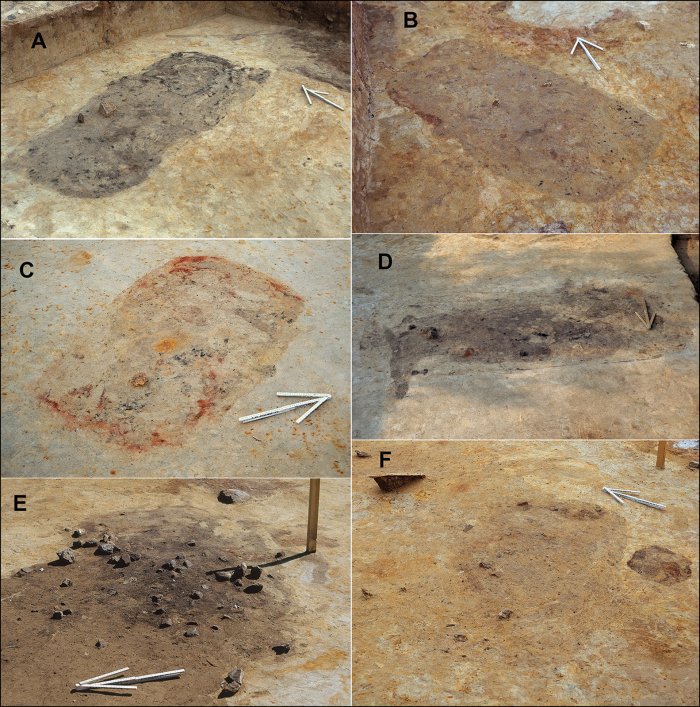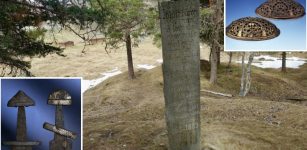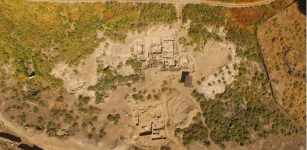Mysterious Stone Age Cemetery Found Near The Arctic – Why Are The Graves Empty?
Jan Bartek - AncientPages.com - There is a large prehistoric hunter-gatherer cemetery south of the Arctic Circle. Scientists call the place a cemetery even though the graves are empty. The Tainaro site was first excavated about four decades ago, but "the unpublished findings and their potential significance have evaded wider recognition. Despite the absence of skeletal evidence, dozens of fifth-millennium BC pits have been tentatively interpreted as burials, the researchers write in their study published in the journal Antiquity.
Credit: Antiquity (2023). DOI: 10.15184/aqy.2023.160
Tainaro is located on a sandy terrace within the vast forests of northern Finland. About 10 300 years ago, a continental ice sheet covered the region. Scientists who comprehensively analyzed the unusual Tainaro pits have suggested this mysterious prehistoric site is most likely a large Stone Age cemetery dating to around 6,500 years ago.
In 2018, a team from the University of Oulu identified 115 to 200 pits at Tainaro. Most were rectangular in shape with dimensions around 7 feet in length and 2.5 feet in depth.
If this was indeed a Stine Age cemetery, it is strange these ancient pits contain no human remains.
"Most of these rounded rectangular pits contained evidence of burning, with occasional fragments of stone debitage and burnt bone, and some contained artefacts. Traces of red ochre were found in 23 pits, but only as small concentrations, patches or streaks," the study informs.
By comparing the pits to other Stone Age archaeological findings, researchers concluded that they were likely burial sites used by roaming peoples who would have foraged, hunted and fished in the region.
"Tainiaro should, in our opinion, be considered to be a cemetery site," researchers said, "even though no skeletal material has survived at Tainiaro."
"Complicating their conclusion, though, was the evidence of burned material found inside some of the pits, suggesting they may have been hearths. However, the traces of charred material were insufficient to prove pyrotechnic use.
This finding, though, indicates the possibility that the site was not solely used for burying the dead.
Examples of pit features at Tainiaro. Credit: Antiquity (2023). DOI: 10.15184/aqy.2023.160
"Indeed, it has recently been argued that Mesolithic places for the dead were also places for the living and some sites previously interpreted as cemeteries were in fact habitation sites with burials dug beneath the dwellings," researchers said.
With that possibility in mind, researchers said Tainiaro should not be considered a single-purpose site, but rather it may have served multiple aims.
If it was used, at least partly, as a gravesite, it would rank among the most sizable Stone Age cemeteries in northern Europe," the Charlotte Observer reports.
Finland alone has more than 200 Stone Age burial sites, most of which are exceedingly small, Hakonen said.
"There are a few sites with around 20 burials, but even these are anomalies," Hakonen said. "But more than 100 burials is perplexing, and more than 200 is astounding."
Arctic Circle, Finland. Credit: Adobe Stock - Matthew
Tainiaro is located in a sub-Arctic region with heavy winter snowfalls and temperatures that drop below 20 degrees Fahrenheit.
The fact that a large cemetery seems to have existed near the Arctic Circle is surprising and challenges previously held impressions of far northern Europe, hinting that large-scale, complex societies may have existed in the region, despite the harsh environmental conditions.
"I think the real implication is to our cultural compass," Aki Hakonen, an archaeologist with the University of Oulu in Finland and an author of the study, told Newsweek. "We expect to find less interesting stuff going on the farther north we go. But the north is a magical place, and it holds many surprises—Tainiaro being just one of them."
"If archaeology reorients itself to consider the north not as a periphery but as a core place of importance in its own right, we would gain access to a much more thorough understanding of humanity's past," he said.
A diagram of the excavated areas and pits. Credit: Antiquity (2023). DOI: 10.15184/aqy.2023.160
"We have reviewed the archival material from the original excavations and undertaken further test excavations to confirm some of the findings. We argue that the site of Tainiaro was most likely, although not certainly, a large Stone Age cemetery of the fifth millennium BC.
If correct, it would be among the largest such sites to date to this period known in northern Europe. We have interpreted as many as 44 of the pits excavated at the site as burials and, since only one-fifth of the site's area has been excavated, the total number could be more than 200.
The site is unusual in other ways too, not least because of the range of activities attested and its location in the northern subarctic, further north than any other known large cemetery of this date. Many questions about Tainiaro remain unanswered.
For the time being, however, the notion that a large cemetery seems to have existed near the Arctic Circle should cause us to reconsider our impressions of the north and its peripheral place in world prehistory," the research team concluded in their study published in Antiquity.
Written by Jan Bartek - AncientPages.com Staff Writer
























